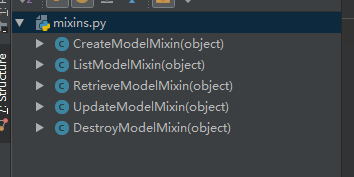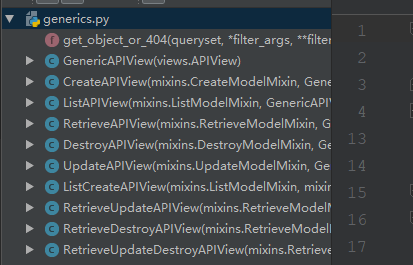Django rest framwork之view
基于Django的View实现Json数据的返回:
# _*_ encoding:utf-8 _*_ __author__ = 'LYQ' __data__ = '2018/8/13 15:21' import json from django.views.generic.base import View from django.http import HttpResponse,JsonResponse from .models import * class GoodsView(View): def get(self,request): good_list=Goods.objects.all()[:10] datas=[] # for good in good_list: # json_dict = {} # json_dict['name']=good.name # json_dict['goods_desc']=good.goods_desc # json_dict['category']=good.category.name # json_dict['shop_price']=good.shop_price # #时间不是json序列化的对象 # json_dict['time']=good.add_time # datas.append(json_dict) #直接序列化 from django.forms.models import model_to_dict #用来做序列化 from django.core import serializers datas=[] for good in good_list: #image和datetime不能序列化 data=model_to_dict(good) datas.append(data) datas=serializers.serialize('json',good_list) datas=json.loads(datas) # return HttpResponse(datas,content_type='application/json') return JsonResponse(datas,safe=False)
Django rest framwork的简单介绍及安装(可参考官方网站):
Django REST框架是用于构建Web API的强大而灵活的工具包。
您可能希望使用REST框架的一些原因:
- 该网站可浏览API是你的开发人员一个巨大的可用性胜利。
- 身份验证策略包括OAuth1a和OAuth2的程序包。
- 支持ORM和非ORM数据源的序列化。
- 可自定义 - 如果您不需要更强大的功能,只需使用常规的基于功能的视图。
- 丰富的文档和良好的社区支持。
- 受到国际知名公司的使用和信任,包括Mozilla,Red Hat,Heroku和Eventbrite。
要求
REST框架需要以下内容:
- Python(2.7,3.4,3.5,3.6,3.7)
- Django(1.11,2.0,2.1)
以下包是可选的:
- coreapi(1.32.0+) - 模式生成支持。
- Markdown(2.1.0+) - Markdown对可浏览API的支持。
- django-filter(1.0.1+) - 过滤支持。
- django-crispy-forms - 改进的HTML显示以进行过滤。
- django-guardian(1.1.1+) - 对象级权限支持。
安装
使用安装pip,包括您想要的任何可选包...
pip install djangorestframework
pip install markdown # Markdown support for the browsable API.
pip install django-filter # Filtering support
...或者从github克隆项目。
git clone git@github.com:encode/django-rest-framework.git添加'rest_framework'到您的INSTALLED_APPS设置。
INSTALLED_APPS = (
...
'rest_framework',
)
如果您打算使用可浏览的API,您可能还需要添加REST框架的登录和注销视图。将以下内容添加到根urls.py文件中。
urlpatterns = [
...
url(r'^api-auth/', include('rest_framework.urls'))
]
请注意,URL路径可以是您想要的任何内容。
例
让我们看一个使用REST框架构建一个简单的模型支持的API的快速示例。
我们将创建一个读写API,用于访问有关项目用户的信息。
REST框架API的任何全局设置都保存在名为的单个配置字典中REST_FRAMEWORK。首先将以下内容添加到settings.py模块中:
REST_FRAMEWORK = {
# Use Django's standard `django.contrib.auth` permissions,
# or allow read-only access for unauthenticated users.
'DEFAULT_PERMISSION_CLASSES': [
'rest_framework.permissions.DjangoModelPermissionsOrAnonReadOnly'
]
}
别忘了确保你也加入rest_framework了INSTALLED_APPS。我们现在准备创建我们的API了。
注:如果出现utf8 decode的错误,把虚拟环境中的Libsite-packagespipcompat中的_init_.py的75行中的utf8改成gbk从新安装即可。
一.ApiView方式实现api
1.serializers:
#form对应:Serializer,modelform:ModelSerializer from rest_framework import serializers from .models import * class GoodsSerializer(serializers.Serializer): name = serializers.CharField(required=True,max_length=100) click_num = serializers.IntegerField(default=0) goods_front_image=serializers.ImageField() add_time=serializers.DateTimeField() def create(self, validated_data): return Goods.objects.create(**validated_data)
2.views:
from rest_framework.views import APIView
#状态码
from rest_framework import status from .models import * from .serializers import GoodsSerializer
from rest_dramework.response import Reaponse class GoodsListView(APIView): """ List all snippets, or create a new snippet. """ def get(self, request, format=None): goods = Goods.objects.all()
#many=True,goods是一个列表 goods_serializer = GoodsSerializer(goods, many=True) return Response(goods_serializer.data) def post(self,request,format=None): serializer=GoodsSerializer(data=request.data)
#验证字段是否合法 if serializer.is_valid(): serializer.save() return Response(request.data,status=status.HTTP_201_CREATED) return Response(request.data,status=status.HTTP_400_BAD_REQUEST)
3.ModelSerializer:
class GoodsSerializer(serializers.ModelSerializer): # 替换默认的category category = GoodsCategorySerializer() # 可能有多条many=True images = GoodsImageSerializer(many=True) class Meta: model = Goods # fields=('name','click_num','market_price','add_time','goods_front_image') # 外键为id,想要完整信息,嵌套Serializer fields = ('__all__')
二.GenericView方式实现api接口
from rest_framework import mixins from rest_framework import generics #基于mixins,必须重载get函数 class GoodsListView(mixins.ListModelMixin,generics.GenericAPIView): """ 商品详情页 """ queryset = Goods.objects.all()[:10] serializer_class = GoodsSerializer #必须重写,不然默认无法接受get请求 def get(self, request, *args, **kwargs): return self.list(request, *args, **kwargs)
三.Viewset和router实现api接口和配置
1.viewset中的view:

2.GenericViewset:
继承了ViewSetMixin和GenericAPIView,ViewSetMixin重写了as_view方法,initialize_request方法,initialize_request方法设置了很多action,在动态使用serializer时有很多的好处

class ViewSetMixin(object): """ This is the magic. Overrides `.as_view()` so that it takes an `actions` keyword that performs the binding of HTTP methods to actions on the Resource. For example, to create a concrete view binding the 'GET' and 'POST' methods to the 'list' and 'create' actions... view = MyViewSet.as_view({'get': 'list', 'post': 'create'}) """ @classonlymethod def as_view(cls, actions=None, **initkwargs): """ Because of the way class based views create a closure around the instantiated view, we need to totally reimplement `.as_view`, and slightly modify the view function that is created and returned. """ # The suffix initkwarg is reserved for displaying the viewset type. # eg. 'List' or 'Instance'. cls.suffix = None # The detail initkwarg is reserved for introspecting the viewset type. cls.detail = None # Setting a basename allows a view to reverse its action urls. This # value is provided by the router through the initkwargs. cls.basename = None # actions must not be empty if not actions: raise TypeError("The `actions` argument must be provided when " "calling `.as_view()` on a ViewSet. For example " "`.as_view({'get': 'list'})`") # sanitize keyword arguments for key in initkwargs: if key in cls.http_method_names: raise TypeError("You tried to pass in the %s method name as a " "keyword argument to %s(). Don't do that." % (key, cls.__name__)) if not hasattr(cls, key): raise TypeError("%s() received an invalid keyword %r" % ( cls.__name__, key)) def view(request, *args, **kwargs): self = cls(**initkwargs) # We also store the mapping of request methods to actions, # so that we can later set the action attribute. # eg. `self.action = 'list'` on an incoming GET request. self.action_map = actions # Bind methods to actions # This is the bit that's different to a standard view for method, action in actions.items(): handler = getattr(self, action) setattr(self, method, handler) if hasattr(self, 'get') and not hasattr(self, 'head'): self.head = self.get self.request = request self.args = args self.kwargs = kwargs # And continue as usual return self.dispatch(request, *args, **kwargs) # take name and docstring from class update_wrapper(view, cls, updated=()) # and possible attributes set by decorators # like csrf_exempt from dispatch update_wrapper(view, cls.dispatch, assigned=()) # We need to set these on the view function, so that breadcrumb # generation can pick out these bits of information from a # resolved URL. view.cls = cls view.initkwargs = initkwargs view.suffix = initkwargs.get('suffix', None) view.actions = actions return csrf_exempt(view) def initialize_request(self, request, *args, **kwargs): """ Set the `.action` attribute on the view, depending on the request method. """ request = super(ViewSetMixin, self).initialize_request(request, *args, **kwargs) method = request.method.lower() if method == 'options': # This is a special case as we always provide handling for the # options method in the base `View` class. # Unlike the other explicitly defined actions, 'metadata' is implicit. self.action = 'metadata' else: self.action = self.action_map.get(method) return request def reverse_action(self, url_name, *args, **kwargs): """ Reverse the action for the given `url_name`. """ url_name = '%s-%s' % (self.basename, url_name) kwargs.setdefault('request', self.request) return reverse(url_name, *args, **kwargs) @classmethod def get_extra_actions(cls): """ Get the methods that are marked as an extra ViewSet `@action`. """ return [method for _, method in getmembers(cls, _is_extra_action)]
3.继承genericviewset的view写法:
GenericViewSet继承于GnericAPIView,没有重写get,post等方法,因此还需要继承mixin
class GoodsListViewSet(mixins.ListModelMixin,mixins.RetrieveModelMixin,viewsets.GenericViewSet): """ 商品详情页,分页,搜索,过滤,排序 """ #配置ip限制访问次数 throttle_classes = (UserRateThrottle,AnonRateThrottle) queryset = Goods.objects.all() serializer_class = GoodsSerializer #分页 pagination_class = GoodsPagination #配置认证类,防止公开网页(未登录可查看)不能访问 # authentication_classes = (TokenAuthentication,) filter_backends=(DjangoFilterBackend,filters.SearchFilter,filters.OrderingFilter) #字段过滤(DjangoFilterBackend) # filter_fields = ('name', 'shop_price') filter_class=GoodsFilter #搜索过滤(rest_framework.filters.SearchFilter) search_fields = ('name','goods_brief','goods_desc') #排序过滤(rest_frameworkfilters.OrderingFilter) ordering_fields = ('sold_num', 'shop_price') def retrieve(self, request, *args, **kwargs): instance = self.get_object() instance.click_num+=1 instance.save() serializer = self.get_serializer(instance) return Response(serializer.data)
viewset和router配套使用:
第一种:配置url:
1 #在url.py文件中 2 #配置GoodsListViewSet 3 good_list=GoodsListViewSet.as_view({ 4 #把get请求绑定到list方法上 5 'get':'list', 6 }) 7 urlpatterns = [ 8 #把good_list放入url中 9 url('^goods/$',good_list,name='good_list'), 11 ]
第二种:(使用router)
from rest_framework.routers import DefaultRouter router = DefaultRouter() # 配置goods的url router.register(r'goods', GoodsListViewSet, base_name='goods') #在调用router.urls时会自动把router中转换为url配置 urlpatterns = [ url('^', include(router.urls)), ]
四.View继承关系
1.View继承关系(差异就是不同的mixin):
GnericViewSet(drf)【比GnericAPIView继承增加了一个ViewSetMixin,在url中绑定了,router可以使用,还有实现了initialize_request方法设置了很多action方便不同serializer的使用】———>GnericAPIView(drf)【增加了筛选过滤分页,serializer等】———>APIView(drf)———>View(django)
2.mixin:
CreateModelMixin
ListModelMixin
RetrieveModelMixin
UpdateModelMixin
DestroyModelMIxin

意境定制好了的view组合(继承GericAPIView不同的mixin实现不同的功能):
